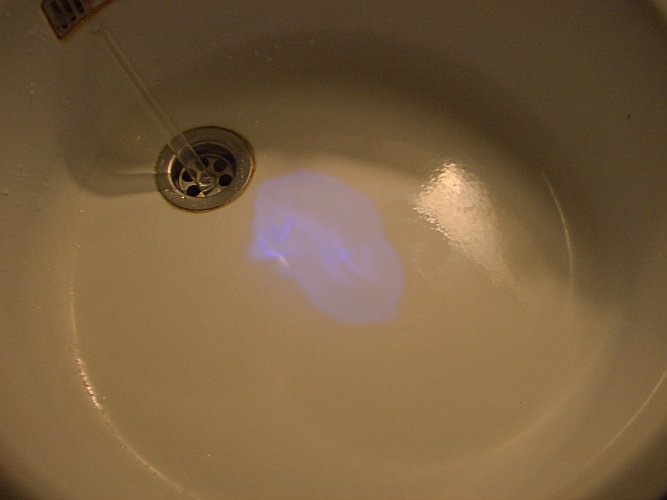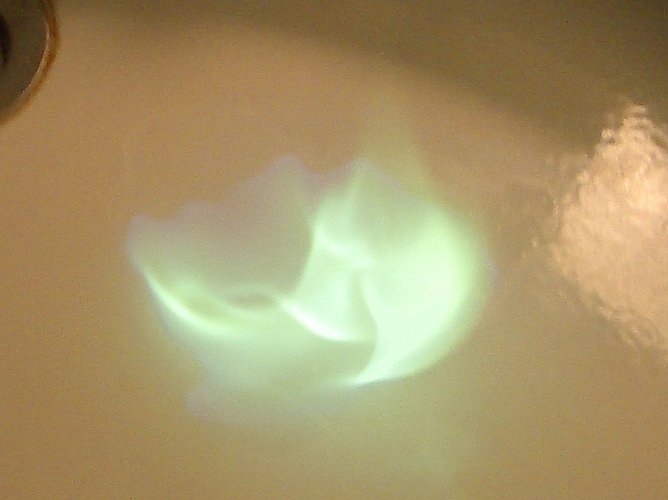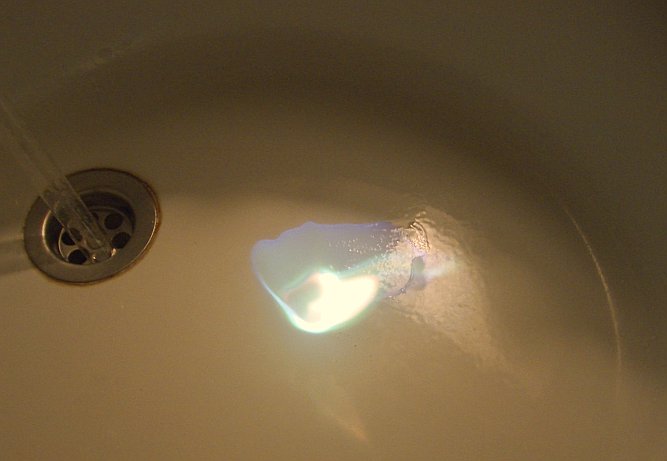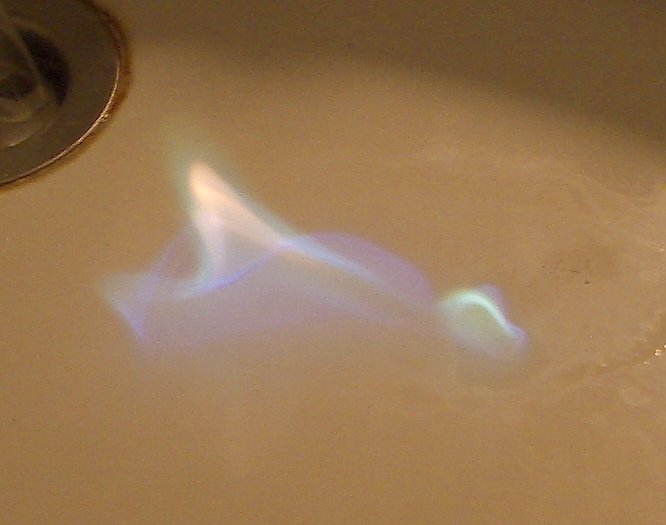


Borate esters and green fire
On this page, it is shown how a pure green fire can be obtained. This is remarkably easy. It is done by mixing methanol and boric acid and then lighting the mix. With ethanol a three-colored flame is produced. It is a matter of personal taste, but to my opinion the pure green flame looks most special. It is really cool to see such a green fire.
Here, some pictures and videos of this simple but nice experiment are given.
![]()
![]() Required
chemicals:
Required
chemicals:
-
boric acid
-
methanol
-
ethanol (96%, denatured is OK)
![]() Required
equipment:
Required
equipment:
-
test tube
-
cigarette lighter
-
glass plate
![]() Safety:
Safety:
- Methanol is toxic, avoid inhaling vapor of this;
- Methanol and ethanol are very flammable;
-
 In this experiment
an open fire is created deliberately. Before performing this experiment be
really sure that no open bottles with ethanol or methanol (or any other
flammable solvent) are around.
In this experiment
an open fire is created deliberately. Before performing this experiment be
really sure that no open bottles with ethanol or methanol (or any other
flammable solvent) are around.
![]() Disposal:
Disposal:
- There hardly is any waste. If some crystals of boric acid remain, simply flush them down the drain. Small amounts of ethanol or methanol waste can be burnt and test tubes and glass vials can be rinsed with water.
![]()
The methyl ester of boric acid
This experiment is very simple. Take 1 ml of methanol and pour this on a clean glass or ceramic surface and quickly light the methanol in a dimly lit room with a cigarette lighter. This results in a pale blue flame.

Take another 1 ml of methanol. Add a spatula of solid boric acid to this. Most of the acid quickly dissolves in the methanol. Pour this solution on a clean glass or ceramic surface and quickly light again. This results in a beautiful green flame, which is much lighter than the pale blue flame of pure methanol. The picture below shows that the flame gives much more light. The flame is brighter, but the walls of the sink also are lit with a greenish light.

The following picture shows a close up of the green flame. Nice details are shown and it also shows that the borders of the flame are pale blue. The flame is totally free of orange color.

![]()
The ethyl ester of boric acid
This experiment is very similar to the experiment with methanol. The flame of the pure ethanol is very similar to the flame of pure methanol. No picture is shown of that, it just is pale blue.
The flame of the ethanol with boric acid added to it differs quite a lot from the flame of the methanol with the boric acid. Now a mix of colors can be observed. Blue, orange and green.

The brightest parts of the flame are orange, with green rims around them and the borders of the flame are pale blue.
Below follows a close-up of a flame of the ethanol with boric acid added. This picture shows blue, orange and green, all in one fire.

Below follows a set of 4 videos, which nicely demonstrate the burning of methanol, and the burning of methanol with boric acid dissolved in it.
Two videos are made in a darkened room:
- burning of methanol (2.3 MByte)
- burning of methanol, with dissolved boric acid (3.9 MByte)
The other two videos are made in a room during daytime, but the amount of daylight in the room only is limited:
- burning of methanol (1.1 MByte)
- burning of methanol, with dissolved boric acid (5.0 MByte)
The four videos nicely demonstrate the bright green color of the fire with the boric acid, but they also demonstrate that the light output of a fire of methanol only is very low. Only in a darkened room, the flames of burning methanol are clearly visible.
![]()
Discussion of results
It is known quite well that alcohols (organic compounds with a -OH group attached directly to a carbon atom) can form esters with many organic acids.
The generic reaction is as follows:
R-OH + HOC(O)-R' ↔ R-O-C(O)-R' + H2O
Here, R and R' are generic organic radicals, e.g. methyl, ethyl. Usually sulphuric acid is needed to absorb the water formed, in order to have acceptable yield of the ester.
Esterification also can occur with inorganic acids. A well known and very easy to perform esterification is the formation of the nitrite ester of methanol:
H3C-OH + HO-NO ↔ H3C-O-NO + H2O
Another very easy to perform esterification with an inorganic acid is with boric acid. This reaction can be performed with methanol and also with ethanol, although the reaction with methanol is somewhat easier.
Boric acid is a tri-basic acid and esterification can occur on each of the OH-groups of the boric acid. A strongly simplified equation is the following. In reality one can also expect boric acid with only one methyl group or two methyl groups.
3CH3OH + B(OH)3 ↔ B(OCH3)3 + 3H2O
The nice thing about these borate esters is that they burn with a true green flame. Just like normal fire, but green instead of orange. This looks very cool and one has to see it oneself in order to fully appreciate.